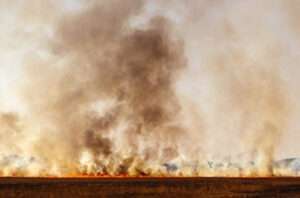MANHATTAN, Kan. — While most prescribed fires in Kansas are conducted during the dormant season — typically March through April — researchers and fire managers suggest growing season burns done between July and September can provide benefits for land managers and public safety.
Dennis Carlson, an assistant state fire management officer with the Kansas Forest Service, said prescribed fires during the dormant season burn more aggressively due to the buildup of dry grasses, woody debris and other litter. The combination of increased fuel load, high winds and low humidity levels can result in increased instances of wildfires, among other challenges.
“One thing we see with prescribed fires in the dormant season is how few days there are to apply prescribed fire due to high winds and low humidity,” Carlson said. “With so few days to burn, it often results in increased smoke management issues due to the significant number of prescribed fires squeezed into these few days.”
Higher levels of humidity and increased vegetation moisture in the growing season help to moderate fire behavior and reduce the risk of an escaped fire, according to Carlson.
Growing season prescribed fires can also be used to manage rangeland woody encroachment, manage certain weed species, and provide wildlife habitat benefits. The benefits and risks along with fuels, wind speeds, humidity and landowner goals are considered when building the prescription for the plan so one can stay within the guidelines to meet the intended resource benefits.
The key with growing season prescribed fire, Carlson noted, is a good amount of previous year’s vegetation present. If there is no to very little previous year’s vegetation present, a growing season prescribed fire will not be successful, he said.
According to KC Olson, professor of range beef cattle nutrition and management at Kansas State University, prescribed-fire research conducted between 2014 and 2020 documented the effects of growing season prescribed fire compared with dormant season prescribed fire on rangeland health and performance of grazing livestock.
“Results were quite compelling,” Olson said. “Prescribed fire applied in either early August or early September strongly suppressed sericea lespedeza over a four-year period. No differences were observed between treatments in native grass composition, forage biomass accumulation, percentage of bare soil, percentage of litter cover or basal plant cover.”
Olson said the diversity of plant species was improved by four consecutive years of prescribed fire in August or September compared to April prescribed fire. In a subsequent three-year study, the performance of grazing yearling cattle was found to be similar between pastures burned in April versus those burned in August.
“Our team of researchers concluded with these projects that comprehensive and cost-effective control of sericea lespedeza could be achieved by moving the prescribed-fire season from spring to late summer without sacrificing animal performance while simultaneously improving all meaningful indices of rangeland health,” Olson said.
Landowners, land managers, and communities in wildland urban interface – an area of transition between unoccupied land and human development – can also take advantage of higher relative humidity and more predictable weather during growing season prescribed fires.
“During the growing season and when within prescription, fires travel slower and have less overall intensity due to the fire needing to use significant energy to drive off the moisture from the previous year’s fuels along with consuming the current green fuels,” Carlson said. “These growing season burns will produce more smoke and steam compared to dormant season burns so one must take this into account by only burning on days when the winds will push smoke away from areas of concern.”
Carlson said there are several things to consider when planning a summer prescribed burn:
One must have an objective and have the proper site conditions, such as appropriate amount of previous year’s vegetation that can carry the growing season burn.
The objectives, weather conditions, notifications, maps, and safety elements need to be built into the prescribed fire plan — and followed. There are many online prescribed fire resources that outline a prescribed fire plan along with the conditions to adhere to.
Consider the current moisture level in the soil and the overall weather trend. It is good to have adequate soil moisture so the grasses will resprout and grow to provide cover for the winter months.
Fire breaks must be properly prepared.
Growing season burns can be a little more exhausting for individuals due to high daytime temperatures and humidity compared to dormant season burns. Take frequent breaks to cool down as needed.
“Growing season burns are starting to get more attention in Kansas due to the benefits they provide. When done properly, growing season burns are another tool for natural resource managers,” Carlson said.
More information on conducting a prescribed burn and the benefits are available from the Kansas Forest Service and K-State Research and Extension.





